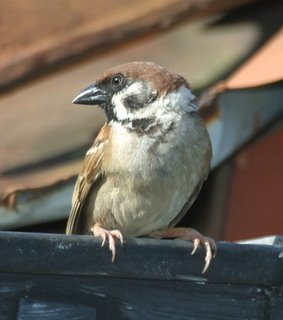The Eurasian Tree Sparrow in Urban Singapore
 The Eurasian Tree Sparrow (Passer montanus) we commonly see around is actually adapted to human habitation. It usually nests in any convenient holes in buildings. Then why is it called a tree sparrow? The colonial Britisher who named it was obviously familiar with it back home as a common woodland bird. It is the House Sparrow (P. domesticus) that is actually found around houses in Europe.
The Eurasian Tree Sparrow (Passer montanus) we commonly see around is actually adapted to human habitation. It usually nests in any convenient holes in buildings. Then why is it called a tree sparrow? The colonial Britisher who named it was obviously familiar with it back home as a common woodland bird. It is the House Sparrow (P. domesticus) that is actually found around houses in Europe. So we ended up with a Eurasian Tree Sparrow around houses and not trees in this part of the world. Once a common bird, it is now slowly being displaced by the more aggressive mynas and crows. Also, many of their traditional nesting areas are being “fenced” off or sealed. Their food sources are also being reduced as food leftover in open-air hawker areas is rapidly removed by efficient cleaners. And not to mention, more and more hawkers are being relocated to air-conditioned outlets where these birds have no access.
Also, in modern Singapore, we are seeing the proliferation of high-rise buildings. And these sparrows are not slow in adapting to modern-day living, as Jeffrey Low, a marine biologist, was quick to notice.
Around his Housing Board block in Toa Payoh, he has seen these sparrows nesting in the electrical trunking boxes. Jeffrey is actually happy to see this new trend, as he would like to see the return of more sparrows as opposed to mynas and crows. Don't we all?
Is this a common thing for sparrows to do? And could this adaptation to nesting in man-made structures be the cause their increase? Or is their resurgence due to some other factor? These are the questions that came to him as he pondered the issue of tree sparrows moving into HDB high-rise buildings.
R. Subaraj, our Bird Specialist, adds that this species follows man wherever he goes, even up hill resorts in the Malaysian mountains. It is a scavenger of human leftover food and for many years was a common sight around open-air food centres and coffeeshops. They roost and nest in roof spaces, light fittings or any other space found in a building.
Although this sparrow is common and everyone takes it for granted, we know relatively little about it. So birders, as well as sometime-birders, please provide more feedback on it - like its nesting habit and behavioural traits.
Contributed by Jeffrey Low
Additional input by R. Subaraj
Labels: Species



4 Comments:
I bought & read Denis Summers-Smith's books (In Search of Sparrows & The Sparrows: A Study of the Genus Passer) a couple of years ago and liked the books. Lots of information about Old World sparrows. They are available at the Library but not for borrowing :(
For borrowing I guess mine are the only books available.
THANKS SLOW. Will try get the book from, where else but Amazon.com. YC
This is a very nice site. I was out looking for "kenmore 295 air cleaners" and found your blog in the process.
Best of luck.
Ever since I learnt about the dramatic decline in sparrow populations throughout the world, I've been curious to learn about the fate of the Eurasian Tree Sparrow in Singapore. How are they doing? What was the latest census and how does it compare with previous years' statistics? I'd be most interested to know.
Whatever the situation, here...i'm trying to raise awareness about World Sparrow Day on 20th March 2011..which is for all sparrows of the world. http://www.worldsparrowday.org/
Will be publishing an interview with the founder of the day soon..if interested do follow http://www.ecowalkthetalk.com
Post a Comment
<< Home